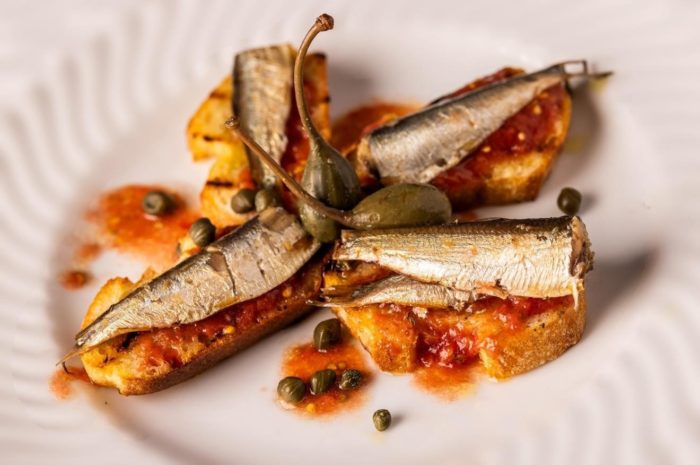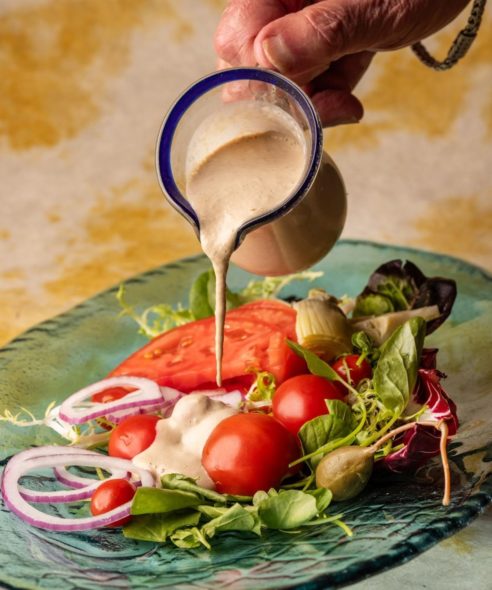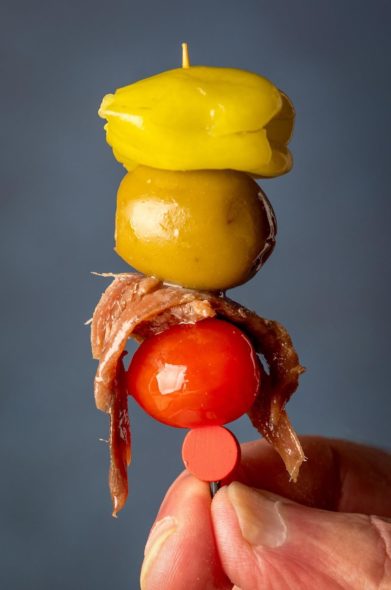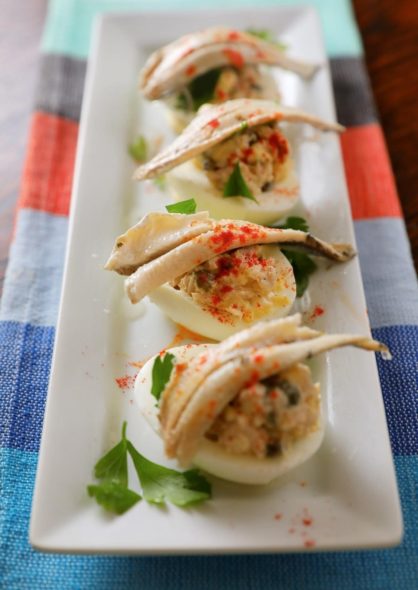All of us have some history with canned (tinned) seafood. Who can forget those inexpensive cans of domestic tuna that helped many of us through college or some low paying time of our lives. When I was growing up in Colorado, my Grandmother insisted that I have a can of tuna or sardines with me when I went fishing or hunting: “survival food” she called it. Very simple food but in recent times tinned fish has become very hip in restaurants as well as with home cooks.
Originally “tinned” seafood was in glass jars probably owing its association to wine in bottles. Food preservation techniques date back to prehistoric times, when humans pickled, salted, and smoked their food to make it last longer. However, the 18th century saw the advent of efficient, effective methods of preservation.
Tinned seafood was one of the greatest inventions in food preservation and it came about in response to a wartime need since it requires no refrigeration. In 1795, the French army offered a 12,000-franc prize (an immense amount then) to anyone who could create a way to store food that could travel to the front without spoiling. In 1810, French chef Nicolas Appert came up with the technique of boiling and sealing in glass bottles. He wasn’t sure why this worked but it was explained later by Louis Pasteur who taught us that the combination of heat-based sterilization and airtight sealing keeps food inside free of spoiling microorganisms.
This is the same technique we do today with canning. (Appert did claim the prize btw). The move to using tins was patented by Englishman Peter Durand, which was a much more efficient container than glass and an industry was born.
Ground Zero now and for a long time has been the Mediterranean especially Spain and Portugal but its widespread including America, Scandinavia and South America especially Costa Rica, the combination of heat sterilization keeps fish inside free of microorganisms.
Not only are there all kinds of fish and shellfish available but, on the Iberian Peninsula (Spain and Portugal) they are packaged with the most inventive and beautiful labels. There are markets there that offer only tinned fish. Definitely something to put on your culinary bucket list.
Probably the most important attribute of tinned fish is that it can provide a shelf life of up to five years. After you’ve opened it canned seafood, like any perishable food of course, should not be left at room temperature for prolonged periods of time. Once opened, it should be refrigerated and covered for up to three days without spoiling.
The popularity of tinned fish (known as conservas in Mediterranean countries) has actually been a culinary favorite for centuries. Producers there have been preserving the sea’s bounty for generations. Tinned sardines, anchovies, mussels and the like are delicious, quick and versatile. All you need to do is peel back that lid, assemble your “sea-cuterie” board and dive into the world of tinned fish. In the recipes that follow feel free to substitute any tinned fish that strikes your fancy.

CATALAN TOMATO TOAST
Serves 4
This is a classic starter and considered the national dish of Catalonia. It’s done variously with anchovies or other tinned fish, cheeses and/or Spanish Jamon serrano (cured Spanish ham).
4 slices rustic bread
2 medium dead ripe tomatoes
Extra virgin olive oil (preferably Spanish) for drizzling
Sea salt to taste
8 small anchovies, preferably smoked or other tinned fish
Toast or grill the bread and set aside. Cut the tomatoes in half. Place a grater over a large mixing bowl. Rub the cut face of the tomatoes until all the flesh is grated. Discard the skin.
Add 3 tablespoons of olive oil to the grated tomato and season to taste with salt.
Spoon the tomato mixture over the slices of toast and top each slice with two of the anchovies or your other favorite tinned fish on top. Drizzle with a little more oil and serve.

TONATTO: A DIFFERENT TUNA SALAD
Serves 6 – 8
The different twist here uses canned tuna to make a “tonnato” sauce which is an elegant Italian aioli made with canned tuna, anchovies, and lemon. It’s typically seen as a condiment for lean meat, especially braised veal. Its roots are in the Piemonte region of Italy. Today you’ll find it served with all sorts of things like tomatoes, asparagus, hard and soft cooked eggs, pasta, even potato chips.
Tonnato sauce (recipe follows)
Mixture of savory greens such as frisée, cress, endive and whatever else you like
Honey lemon vinaigrette (recipe follows)
On chilled plates, spread a nice layer (a couple of tablespoons) of the tonnato sauce. Dress the separated greens gently with vinaigrette and arrange attractively on top of the sauce with a sprinkling of capers.
Tonnato Sauce
Makes 2 cups or so
5 tablespoons extra-virgin olive oil
1 medium peeled and smashed garlic clove
1 six-ounce can tuna packed in olive oil, flaked
3 drained anchovy fillets
1/2 cup mayonnaise
2 teaspoons fresh lemon juice or to taste
2 teaspoons drained capers plus more to garnish
1 tablespoon chopped parsley
Kosher salt and freshly ground black pepper
In a blender, add the oil, garlic, tuna with its oil, anchovies, mayonnaise, egg yolks, lemon juice and capers and process to smoothly puree. Place mixture in a small mixing bowl and stir in parsley and correct seasoning with salt and pepper. Store refrigerated and covered for up to 2 days.
Honey Lemon Vinaigrette
Makes 1 generous cup
2 tablespoons finely chopped shallot
6 tablespoons seasoned rice vinegar
2 tablespoons fragrant honey
4 tablespoons fresh lemon juice
4 tablespoons olive oil
Salt and freshly ground pepper to taste
Whisk all ingredients together and season with salt and pepper. Store covered and refrigerated for up to 3 days.
SALT-CRUSTED POTATOES WITH SALSA VERDE
Serves 6
This makes a wonderful appetizer on its own or served as a side for grilled meats or poultry. Topping with any tinned fish would make it stellar!
Salt-Crusted Potatoes:
2 pounds evenly sized waxy new potatoes, such as fingerling, scrubbed but unpeeled Sea salt flakes
Salsa Verde (recipe follows)
Tinned fish fillets (optional)
Put the potatoes into a wide, shallow pan in which they fit in a single layer. Add 2 tablespoons salt and 1-quart cold water (just enough to cover), bring to a boil, and leave to boil rapidly until the water has evaporated. Then turn the heat to low and continue to cook for a few minutes, gently turning the potatoes over occasionally, until they are dry and the skins are wrinkled and covered in a thin crust of salt.
Pile the hot potatoes onto a plate and serve with the salsa, instructing your guests to rub off as much salt from the potatoes as they wish before dipping them in the sauce and topping with a tinned fish of their choice.
Salsa Verde
Makes about 1 cup
2 cups coarsely chopped parsley
1/2 cup chopped fresh basil or mint
4 (or more) anchovy fillets in oil
2 tablespoons drained capers
2 tablespoons blanched or roasted garlic (see note below)
1 tablespoon finely grated lemon zest 2/3 cup or so fruity extra virgin olive oil
Salt and freshly ground black pepper to taste
Add the parsley, anchovies, capers, garlic, basil and zest to a food processor or blender. With machine running, slowly add the oil until just blended. Sauce should still have a little texture. Season with salt and pepper. Can be stored covered and refrigerated for a day.
SARDINE AND PIQUILLO PEPPER TOASTS
Makes 16
16 1/3-inch-thick baguette slices, cut on diagonal into 3 to 4-inch lengths
Extra-virgin olive oil
1 large garlic clove, peeled, halved
2 4-ounce cans boneless sardines or mackerel in olive oil, drained
Sriracha or other hot chili sauce (optional)
Fresh lemon juice plus lemon wedges for garnish
Very thin sweet white onion slices
2 tablespoons drained capers
16 thick strips piquillo peppers, drained
Preheat broiler. Brush both sides of each bread slice lightly with olive oil. Arrange bread slices on a small baking sheet. Broil until beginning to color, about 1 minute per side.
Rub 1 side of each bread slice with cut side of garlic and cool.
Place bread slices, garlic side up, on serving platter. Divide sardines among bread slices in a single layer. Sprinkle a few drops of sriracha sauce over each, if desired, then a few drops of lemon juice. Top each toast with onion slices, several capers, then strip of piquillo pepper. Garnish platter with lemon wedges and serve.
About Piquillos:
Wonderfully versatile piquillo peppers come exclusively from the small northern Spanish region of Navarra. Nestled between the borders of southern France and Basque territory, the town of Lodosa thrives on a busy trade in piquillo peppers. The peppers take their name from their distinctive, narrow, triangular shape: Piquillo means “beak” in Spanish. At first glance, piquillos look like a variant of sweet bell pepper, but just one bite will tell a different story, as the familiar sweetness gives way to a sneaky heat. Navarra’s piquillo peppers are traditionally roasted over a beechwood fire, which adds a delectable smokiness to their bouquet. The final product is then packed whole in its delicious juices, ready to be sliced, stuffed and puréed into a variety of delicious dishes.

GILDA APPETIZER
Many dishes and drinks have become synonymous with their namesakes. Take for example: Cobb salad, which earned its fame when Bob Cobb, who owned the Brown Derby restaurant in Hollywood, shared an inventive, late-night salad creation with his buddy Sid. Another is the Shirley Temple whose name came from a “cocktail” which in the presence of adults enjoying cocktails, was served a special drink “so she could feel fancy”.
Rita Hayworth, a beautiful and talented dancer and actress gave birth to a finger food (tapa or pinxto) called Gilda named after her most important movie role.
The naming of the Gilda pintxo took place over 60 years ago at a bar in Basque’s San Sebastian called Casa Vallés. The restaurant’s founder would serve pickles as well as olives, gherkins, guindilla peppers, and anchovies as a tapa or pintxo with drinks.
Typically a pickled green guindilla pepper or sometimes a gherkin pickle or sundried tomato, olives and anchovies were all lined up on a toothpick for easy eating.
The name “Gilda” was given to the pinxto for its “verde, salado y picante (green, salty, and spicy)” qualities which could have an additional translation of “little pervert, witty, and spicy” all terms used to describe Hayworth’s title role.
PANZANELLA WITH ANCHOVY AND MINT
Serves 6
1-pound ripe cherry tomatoes
1 teaspoon kosher or sea salt
4 to 6 ounces day-old peasant bread, torn into bite-size pieces
1 small Kirby or pickling cucumber, seeded and diced
1/2 small sweet red onion, peeled and very thinly sliced
2 tablespoons drained capers
Small handful fresh mint (15 leaves) picked and sliced into thin ribbons, divided
For the dressing:
4 anchovy fillets
1 clove garlic
Sea salt and freshly ground black pepper, to taste
1/3 cup good-quality olive oil
2 tablespoons sherry vinegar
Slice the tomatoes in halves or quarters, going for manageable bite-size pieces. Place them in a colander set over a bowl and sprinkle the tomatoes with the salt. Set aside to drain for about 15 minutes (place a plate or bowl below to catch some of the juice).
In a large salad bowl, place the drained tomatoes (reserving the juice), bread hunks, chopped cucumber, red onion, capers, and about half of the sliced mint.
In a mortar and pestle, combine the anchovies, garlic, half of the remaining mint and a small pinch of salt. Pound it aggressively to make a paste.
Add the olive oil and vinegar to the reserved 2 tablespoons of tomato juice. Drop in the anchovy paste and whisk until emulsified. Alternatively, shake it all up in a jar. Taste for seasoning; it may need more salt or a few cracks of pepper.
Pour the dressing over the salad and gently toss. I like to use my hands to toss a panzanella to feel the juices start penetrating the bread. Allow the salad to rest at room temperature for at least 1 hour before serving to allow the bread to soak in the juices.
PAN BAGNAT
Serves 4
A specialty of Provence in the South of France, it literally means “bathed bread”. Originally it was a vegetable salad mixed with pieces of toasted leftover bread that became soaked with the juices after a time. In this version, a split baguette is filled with salad ingredients and canned fish. The loaf is then wrapped in plastic and weighed down so that the loaf becomes moist and compact. Basically, a salade niçoise, between slices of crusty bread. It should be made ahead and is great to take to a picnic because it travels well.
3 plum tomatoes, cored and thinly sliced crosswise
Kosher salt, to taste
1 (5-ounce) can olive oil-packed tuna, drained
1⁄2 small red bell pepper, stemmed, seeded, and chopped
1⁄3 cup extra-virgin olive oil
1 tbsp. Dijon mustard
1 round rustic bread loaf, split (16 to 20 ounces)
1/2 cup fresh celery leaves or thinly sliced fennel
4 thin slices of sweet red onion
1 small Persian cucumber, thinly sliced lengthwise
2 hard-boiled eggs, thinly sliced crosswise
6 oil-cured anchovies, drained
8 oil cured black olives, pitted and chopped
4 large torn basil leaves
Freshly ground black pepper, to taste
Sprinkle tomato slices liberally with salt and transfer to a colander; set aside to drain for 30 minutes. Pat dry with paper towels and set aside.
In a small bowl, break up tuna with a fork, stir in bell pepper and set aside. In another small bowl, whisk together oil and mustard; set dressing aside. Scoop the insides from the bread loaf and discard or reserve for another use. Place tomatoes evenly over bottom of bread and then top with the celery leaves, onion and cucumbers. Spread tuna mixture over top, and then top with egg slices, anchovies, olives and basil. Pour dressing evenly over ingredients, and season with salt and pepper; cover with top of bread, pressing lightly to compact.
Wrap sandwich tightly in plastic wrap and place on a baking sheet. Top with another baking sheet and weight with a cast-iron skillet. Refrigerate for at least 4 hours or overnight. Slice into quarters to serve.
PASTA WITH SARDINES AND BREADCRUMBS
Makes 4 servings
You probably already have on hand what you need in your pantry to make this classic Sicilian recipe. For the sardines look for “2-layer” sardines which are smaller. I have not affiliation with them, but I like “Tiny Tots”. No cheese is used here but a little freshly grated pecorino would be nice. You can substitute any of the canned fish, such as mackerel, herring, or smoked oysters.
Kosher salt
1/4 cup extra virgin olive oil
1/2 cup fresh breadcrumbs from bread with crusts removed
1-1/2 cups chopped onion 1 teaspoon finely chopped garlic
Freshly ground black pepper 3/4-pound long pasta, such as bucatini
Zest and juice form 1 small lemon
2 tablespoons drained capers
2- 4 ounces sardines, mackerel, tuna or other tinned fish packed in extra virgin olive oil
1/2 cup chopped fresh parsley, plus more for garnish
Bring a large pot of water to a boil and add enough salt so that it tastes like the sea. Add 2 tablespoons oil to a medium skillet over medium heat. When it’s hot, add the breadcrumbs and cook, stirring frequently, until golden and fragrant, minutes or so. Remove and set aside.
Add the remaining oil, onion and garlic to the pan, sprinkle with salt and pepper, and cook, stirring occasionally over medium heat until softened, about 5 minutes. Add the lemon zest and juice, capers and sardines; cook, stirring occasionally, until just heated through, about 2 minutes.
Meanwhile, add the pasta to the boiling water and cook until just tender; drain, reserving some of the cooking liquid. Turn the heat under the onions and garlic to medium-high and just beginning to color.
Add the drained pasta to the sardine mixture and toss gently to combine, trying to keep the sardines as whole as you can. Add the parsley, most of the breadcrumbs and some reserved water, if necessary, to moisten. Taste and adjust seasoning, garnishing with more parsley and breadcrumbs.
BEER BATTERED SARDINES
Serves 2 – 4
You can also use tinned mackerel, tuna, trout and anything else you like in this recipe.
Neutral oil, such as grapeseed or canola, for frying
1 cup all-purpose flour
1/2 cup cornstarch 1/2 teaspoon baking powder
Big pinch cayenne pepper
1 12-ounce bottle lager beer
2 4.2-ounce tins sardines packed in lemon and oil
Kosher salt
Lemon wedges and tartar sauce to serve
Pour 3 inches of neutral oil into a medium saucepan and warm to 375°.
In a large bowl, stir together the flour, baking powder and cayenne. Gently stir in the beer with a fork to avoid too much foam. A few clumps are okay; overmixing is not.
Place the sardines in the batter and gently toss to coat. Lift the sardines one at a time from the batter, allowing excess batter to drip back into the bowl. Do this one by one until you have 6 to 8 sardines in the oil, depending on the size of your pan.
Fry the sardines until golden brown, 2 to 3 minutes. Be careful not to overcrowd the pan, as this will drop the temperature of the oil and you’ll end up with soggy, greasy fish. Once the fish are cooked, use a slotted spoon to transfer them to a plate lined with paper towels. Season with a little salt. Repeat this process until all the sardines are fried.
Serve while hot with lemon wedges and tartar sauce.
TUNA MELT
Serves 4
According to the New York Times, tuna melt was accidentally invented in the 1960s at the Woolworth’s lunch counter in Charleston, S.C., when the cook didn’t notice that a bowl of tuna salad had tipped over onto a grilled cheese. Who knows if this story is true, but tuna melt became classic American diner food. Extra-sharp farmhouse style Cheddar cheese is a must. You can serve this open face (my preference) or with a top slice. If using a top prepare like you would a grilled cheese. Up to you. Other canned fish such as salmon, sardines or mackerel make a delicious substitution.
2 split English muffins or 4 slices sourdough, dark rye, or whole grain bread
1 recipe tuna salad (recipe follows) 1 cup shredded extra sharp cheddar cheese
Preheat the broiler and set the rack about 4 to 5 inches from the heat source. Spread the muffins out in a single layer on a baking sheet and toast. Top with the tuna salad and then the shredded cheese. Place the baking sheet under the broiler and heat for 3 to 5 minutes or until the cheese has melted. Serve immediately.
Tuna salad:
Two 4.2-ounce cans tuna in olive oil, drained preferably Ventresca
3 tablespoons finely chopped celery
2 tablespoons finely chopped green onions including the green part
1 tablespoon minced flat leaf parsley
1/3 cup mayonnaise
2 teaspoons whole grain mustard
2 tablespoons drained and chopped capers
Kosher salt, freshly ground black pepper and drops of lemon juice to taste
In a small mixing bowl break up the tuna with a fork. Toss with the celery, onion, and parsley. Add the mayonnaise, mustard and capers and season with salt, pepper and lemon juice to taste. Stir to combine.

TUNA STUFFED EGGS WITH BOQUERONES
Makes 12
The key to this dish is to use the delicious oil packed tuna from Spain or Italy. The very best of them is labeled Ventresca which comes from the belly. Boquerones are special anchovies that are ubiquitous in tapas bars in Spain. They are not the intensely salty and fishy anchovies that most of us are used to. They are white, delicate and typically packed in a combination of oil and vinegar. You’ll find them refrigerated in plastic containers in good delicatessens and I’m addicted to them straight out of the container!
6 hard cooked eggs peeled and cut in half lengthwise
1/2 cup imported oil packed tuna, drained and finely flaked
2 tablespoons mayonnaise
1 tablespoon fresh lemon juice
2 tablespoons drained and chopped small capers
Sea salt and freshly ground black pepper
12 Boquerones anchovies
2 tablespoons finely chopped flat leaf parsley and/or mint
1/4 teaspoon or so Spanish smoked paprika
Place egg yolks in a bowl and mash. Add the tuna, mayonnaise, lemon juice and capers and stir to mix thoroughly. Season to your taste with salt and pepper.
Spoon the yolk mixture into the egg whites. You may have a little more filling than you’ll need which is not a bad thing! Arrange two anchovies on top of each egg and sprinkle with parsley and paprika.
All photographs by John Burgess Santa Rosa Press Democrat
John Ash © 7/23 PD




